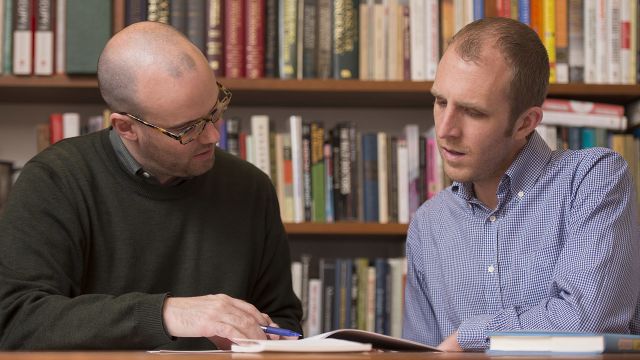People
Grant and Michael
Grant and Michael

“HBS is a place tailor-made for students who are driven to do research that has impact.”
— Mike Norton
We are currently working on a number of projects investigating decision-making, from how much money millionaires think they need to be happy to whether the feeling of being observed might decrease people’s likelihood of cheating on their taxes. One project seeks to understand the decisions people make when disposing of things they no longer want — and change those decisions for the better.
Research focus
Currently, municipal waste management companies provide limited options for disposal: a trash can, a recycling bin, and in some locations, a compost bin. But what happens when someone wants to dispose of something that might be useful to someone else, like a used umbrella? You could always donate the umbrella, but that would require making a trip to goodwill or holding onto the umbrella until a donation-based organization schedules a pick-up. So, more often than not, the umbrella is going in the trash.
Grant: When I moved to Boston I was surprised to see a number of make-shift “Free” boxes placed in front of people’s homes filled with items they were inviting their neighbors and other passers-by to take. Perhaps there needs to be a more simple process allowing people to dispose of their unwanted, but still useful items? A process that didn't require a trip to a donation center, and alleviated the guilt that might be associated with filling up precious landfill space.
What would happen if waste management companies provided a bin for donations that was picked up weekly along with the other bins? In this bin you could place the things you no longer wanted, but perhaps your neighbors or other people might. Would people use these bins? Would it reduce waste? And would it provide any benefits to the consumer… perhaps making them feel more connected to their neighbors or boosting their positive feelings?
Findings & implications
Our findings have implications for both consumers and the design-side of waste disposal. We find that when given a “social recycling” (or donation) bin, waste is reduced by about 30% from both recycling and trash bins. People who use these bins also feel happier compared to those who don't, and they feel closer to the people they imagine being recipients of their unwanted items.
The collaborative process
Grant: When coming to HBS, I imagined I would have little face-time with the faculty because of their demanding schedules. However, I generally see Mike multiple times a week and have regular meetings about our research. It turns out the faculty are really passionate and excited about research, and count it as one of their most engaging pursuits. They make time to talk about it.
In my first year at HBS, I started working with a number of faculty on various projects that I am excited about. It feels a bit like a start-up in the sense that I'm given the necessary support to not only pursue ideas, but to develop ideas. And the freedom to partner with various faculty.
Mike: We were thrilled when Grant chose to pursue his graduate studies in the Marketing program here. HBS is a place tailor-made for students who are driven to do research that has impact. Grant came with experience running both organizations and field experiments, and so we knew that he would be likely to do “big” research that tackled problems that, if solved, could have big benefits. Our social recycling project is a great example, a reimagining of how we think about “trash” with the potential to increase consumers’ happiness while decreasing waste. We are always looking for the all-too-rare students who want to get trained as social scientists, but in the pursuit of important problems.
Grant: I feel extraordinarily fortunate to work with Mike. He once guessed that only 3% of human behavior has even been studied, leaving plenty of room for new ideas! I like coming to Mike with a new idea and brainstorming ideas on how to study it. In fact, Mike has created a great community of student scholars. We have weekly lab meetings with all the other students Mike collaborates with, and the group also runs studies together in the lab each month. Not only is Mike brilliant and funny, he’s generous with credit and his time. Before presenting one of our projects at my first academic conference, Mike spent hours helping me develop my presentation skills in preparation.
Mike: For me, the very best part of my job is the freedom to collaborate with whoever I want on whatever I want. There is no other job in the world that allows so much of both kinds of flexibility. And collaborations with students are particularly interesting because, to put it simply, I have no clue what great ideas my student will come up with, meaning that every meeting is a chance to do some brainstorming on a new project. Grant took some casual conversations about whether we could get people to “trade in their trash” into a full-blown research project that will turn into an interesting paper — all by the end of his first year.
